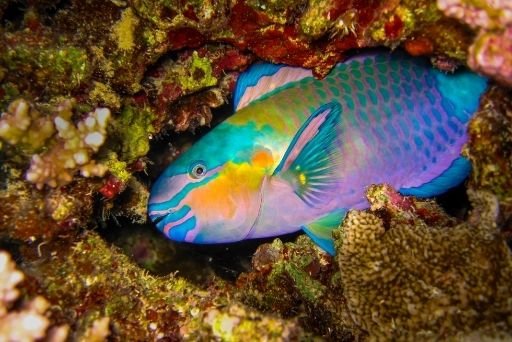What should you know about the Parrotfish (Scaridae)?
All marine life lovers must be very keen to know interesting facts about all the species residing in marine life. Today, in this article, we will talk about one such species with very distinctive traits and is very beautiful, the Parrotfish. They are a group of 90 species that belong to the Chordata phylum and Actinopterygii class. Their binomial name is Scaridae. The exceptional richness of this species is found in the Indo-Pacific. Parrotfish play a prime role in the procedure of bioerosion. So, learn more.
Physical features of the Parrotfish
Parrotfishes are long and elongated fishes with blunt heads and deep bodies. The bright colouration of their body catches the eyes of the photographers and the artisans. They have large scales with characteristics of a bird, and they possess a beak formed from the fused teeth of the jaws.
The main use of the beak is to scrape off the Algae in the deep waters and chisel out the soft and tender part of the coral from the coral reefs. The length of the Parrotfish ranges from 1.2 m [4 feet], and their average weight is 20 kgs [45 pounds]. The male fish is green and orange in colour, whereas the female ones are blue and yellow.




Habitat of the Parrotfish
The Parrotfish is mostly found in the Western Atlantic from Florida, Bermuda and the Bahamas. They stay in deep contact with coral reefs at depths from 3 to 25 m. The young Parrotfishes take shelter in the mangroves. These species are very important to the Parrotfish as they provide safe food and a secured shelter against predators.
Diet of the Parrotfish
Parrotfishes are generally herbivores and only consume microscopic organisms and sponges. Dead algae are considered their favourite food, and it is mainly found in the corals released by the reefs. The way Parrotfish eat their food is very peculiar. They use their strong teeth to break and crush the tough materials.
Behaviour and temperament of the Parrotfish
The Parrotfish is a very social species seen scavenging for food in groups. These groups consist of females who are submitted to one single male. They make groups of about forty specimens who together look for food in the bed of coral reefs. In some situations, the group is led by a male Parrotfish, commonly known as the Super Male. The super male is those females who have reversed their sex.
They are very territorial. The young Parrotfishes are seen swimming alone when adults begin to swim using their dorsal fins. Mostly all the Parrotfishes are extremely territorial, but some are even nomadic, too, who do not defend any specific territory.
Breeding and mating
Parrotfishes are pelagic spawners. The male Parrotfish joins in the group and grabs the attention of the female Parrotfish with the help of its bright colouration of the body. The spawning generally occurs during sunset time. These species come in groups in some specific areas of the ocean and then distribute their eggs once they are fertilised with the help of the ocean currents. When the eggs hatch, the larva of the fish floats in the epipelagic area near the water surface.
When they cross the length of 12 cm, they are regarded as young Parrotfish and settle down to the depth of the reefs underwater. They are only able to reproduce when they exceed 60 cm in length. Considering these factors, the replacement of Parrotfish is slow.


Adaptation of the Parrotfish
The Parrotfish has two natural predators. Moray Eel and the Reef Shark are the two predators who eat Parrotfish. Predators such as sharks, snappers swim past the Parrotfish without eliciting any kind of reaction. This misleads the Parrotfish and eventually becomes the prey of these groupers.
Facts about Parrotfish
The Parrotfish is one of the fascinating species of fish. Their teeth are composed of fluorapatite, one of the world’s hardest biominerals, and it is much harder than copper, gold and silver. It uses pectoral fins to swim through the water. The group of Parrotfishes is led by a super male who gets this position by reversing their genders. In some cases, the Parrotfishes change their gender in one lifetime.
Their growth rate is comparatively faster than other species, and their average lifespan is 5 to 6 years. However, the larger ones grow very slowly, and their life expectancy reaches up to 15 years. It is also seen that some parrotfishes migrate to particular regions to reproduce in large spawning aggregations.
The bottom line
The Parrotfish is among the most distinctive species. They are extremely brightly coloured and look like a bird. They also play a significant role in the coral reef ecosystem. When they scrape Algae, they use their teeth to rip the small chunks. This helps in bleaching the corals and provides room for the growth of new corals. Some Parrotfishes even build a transparent cocoon made of mucus secreted from glands in the gills. So, they are quite interesting.




